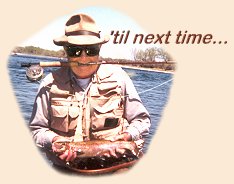
| ||
|
May 22nd, 2006
|
E-mail message #1I have read in your responses about establishing population of aquatic insects in streams but did not see any references on establishing population in lakes. My question: "What is your knowledge or experience with stocking lakes with aquatic insects?" Thank you for your time and consideration, best regards, Mike Harvell
E-mail message #2
"The nymphs were collected in a river about 40 miles from the lake. Actual it is very easy. Just wait a month before they are hatching, scrape the bottom sand in the river and sort the nymphs out. Put them in a recipient with wet leaves and some twigs etc. They do not need to be under water. Example: once we had them overnight in a basket with only wet leaves. When we finally released them they swam nicely to the bottom. We repeated this for 5 years. The last stocking was about 4 years ago. Last Sunday I was at the lake and discovered more than a hundred duns/spinners hanging and dancing around the trees. So, it turned out as a success."The mayflies were classified by my Belgium contact, again in their own words: "The specie(sic) of the mayfly is the Ephemera vulgata." This is the one of the most brazen, intriguing discoveries that I have made in my travels around the world working and learning on the side what other groups do with different fisheries. This is way beyond ku fishing in Taiwan but maybe not beyond the Cherry Salmon of Taiwan. If you have other questions, I will try to find out more information. I want to travel down to see the lake, but I am running out of time in Holland. Best regards, Mike
Q.
What is your knowledge or experience with stocking lakes with aquatic insects?
A.
Well, the short answers are "zero" and "none". However, let me elaborate.
I've been asked previously about the feasibility of trying
to stock insects in streams where they don't exist, and my
usual response was along the lines of (1) I've never heard
of it being done successfully, (2) if insects don't occur
naturally in a stream and there are viable populations nearby,
there is probably a good reason why they don't occur in the
barren stream, and (3) arbitrarily stocking new species
where they don't exist isn't always a good idea; it can cause
unexpected problems.
Now to get a bit more specific about the folks in Holland
who have evidently established a viable population of
Ephmera vulgata by moving nymphs collected
in a river and introducing them into a lake 40 miles away.
Quite frankly, this is the first episode of this type that
I've heard of. I don't doubt that they did it, but I am
surprised that they were successful moving nymphs acclimated
to a flowing water environment into a still water environment.
Perhaps the river was lake-like, large and slow flowing.
This would make more sense.
I wanted to explore this, so I called some colleagues. One
told me that he had read of a case where mayfly eggs attached
(they're sticky) to boards, were kept wet, transported across
the Atlantic on a ship, and survived and successfully established
viable populations in southeastern US streams. He told me the
book that he thought documented this; I spent an hour going
through the book and could find no such account. I then called
three aquatic entomologists located in Georgia and Florida and
asked if they had heard of this story; none had, though the
mayfly expert in Florida is checking the story out among his
colleagues. If I learn anything further, I'll let you know.
Best wishes, ~ Bert
If you have a question, please feel free to contact me.
|
| If you would like to comment on this or any other article please feel free to post your views on the FAOL Bulletin Board! |
 The 'Stream Doctor' is a retired professional stream ecologist and
author, now living in the West and spending way too much time
fly-fishing. You are invited to submit questions relating to
anything stream related directly to him for use in this Q & A Feature
at
The 'Stream Doctor' is a retired professional stream ecologist and
author, now living in the West and spending way too much time
fly-fishing. You are invited to submit questions relating to
anything stream related directly to him for use in this Q & A Feature
at